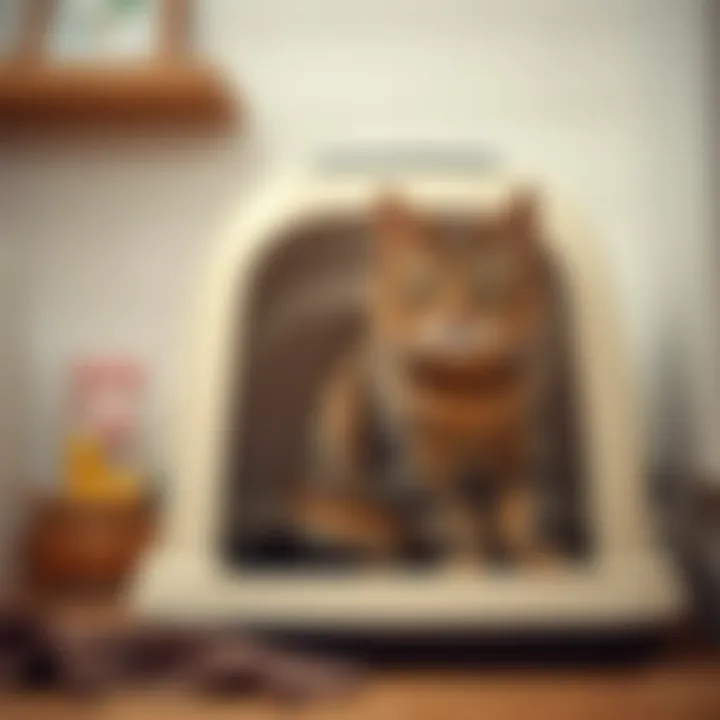Effective Solutions to Prevent Your Cat from Pooping Everywhere


Intro
Dealing with a cat that doesn't follow litter box etiquette can make you pull your hair out. You might feel like you’re living in a feline version of a disaster movie. But hold on a minute! Before jumping to conclusions or pointing fingers at your furry friend, it’s essential to delve into their world. By understanding what could be behind this behavior, you can find ways to tackle the situation head-on.
Whether it’s a tummy issue or a case of feline spite, recognizing the root cause is vital. In this guide, we're going to put on our detective hats and explore every angle—from health concerns to environmental factors that can trigger this behavior. You'll learn how to create a space that's just right for your cat, plus techniques to encourage better litter habits. All this can help strengthen the bond between you and your four-legged companion.
Pet Care Essentials
Every cat has its own set of needs to thrive, and meeting those needs is paramount in curbing inappropriate elimination. Below are the vital components that every caring pet owner should focus on:
Daily Nutrition Requirements
What goes into your cat's bowl directly impacts their overall health and behavior. Cats should have a balanced diet rich in proteins, essential fatty acids, vitamins, and minerals. What’s the catch? Not all cat food is created equal. Look for options that list meat as the primary ingredient. Brands such as Royal Canin or Hill's Science Diet have formulated their meals with optimum nutrition in mind.
Exercise and Playtime
A bored cat can quickly turn destructive. Encouraging your pet to move by providing engaging toys will help alleviate stress and health problems. Scheduled playtime is essential to keep your cat active and responsive. Feather wands and laser pointers are popular choices for stimulating their predatory instincts—after all, they are born hunters, and it’s crucial to honor that within your home environment.
Grooming Tips
Regular grooming is an aspect that should not fall by the wayside. Cats spend a significant portion of their time grooming themselves; however, some may benefit from a little extra help, especially long-haired breeds. Regular brushing not only reduces the risk of fur balls but also strengthens your bond with your pet.
Health and Wellness Check-ins
Routine vet visits ought to be on your radar. Whipping together a wellness plan that includes vaccinations and dental check-ups can catch issues before they develop into serious problems. Pay attention to any alteration in your cat's behavior, like whether they’re eating or drinking less. Such signals can hint toward underlying health concerns that could be a reason for their litter box failures.
Behavior & Training
Understanding your cat's behavior is the backbone of correcting unwanted actions. All cats have unique personalities, and knowing yours will help you tailor solutions effectively.
Understanding Your Pet's Body Language
Cats communicate through their body language. A low tail might mean they feel unwell, while dilated pupils often indicate excitement or fear. Recognizing these signs can help you adjust your approach and create a safe environment that fosters better habits.
Basic Training Techniques
Training a cat isn’t the same as training a dog. Positive reinforcement works wonders. For instance, rewarding your cat with treats or encouraging verbal acknowledgments when using the litter box can reinforce the desired behavior.
Behavioral Concerns & Solutions
If your cat suddenly refuses to use its litter box, get to the bottom of it quickly. Common issues might stem from stress, the introduction of new pets, or even a dirty litter box. Identifying the source can help you mitigate problems with targeted solutions.
Socialization Tips
Socializing your cat from a young age is key. Introduce them to various environments, noises, and, if appropriate, other animals at their own pace. The more comfortable they become in diverse settings, the less likely they will exhibit behavioral issues later on.
Pet Home Environment
Creating a welcoming and safe living environment is crucial in shaping your cat's behavior. A little planning can go a long way.
Creating a Pet-friendly Space
Your home should cater to your cat’s instincts. Designate a quiet area for their litter box away from high-traffic spots, and choose an easily accessible place. Privacy can work wonders in encouraging them to use the box consistently.
Safety Measures and Hazards to Avoid
Cat-proofing your home can avoid adversities. Keep hazardous materials out of reach and secure loose cords to protect curious paws. Houseplants should also be checked; not all greenery is cat-friendly. That pretty lily you adore? It could be lethal for your feline.
Choosing the Right Toys and Accessories
Invest in a variety of toys that cater to different play styles, be it interactive, solo play, or puzzle toys that stimulate their intellect. Scratching posts are also essential; make sure they are high enough and positioned correctly to draw your cat's attention.
Setting Up a Comfortable Resting Area
Ensure your cat has cozy places to nest. Cats love warmth and security, so having a designated bed in a quiet corner of your home allows them to recharge. They will be less likely to stress and act out when they have their nook to retreat to.
Pet Health Issues
Sometimes, inappropriate elimination can stem from health issues rather than behavioral problems. By recognizing certain signs, you can take prompt action.
Recognizing Signs of Illness
Pay attention to any sudden changes in behavior or litter box habits. Increased thirst, appetite changes, or frequent meowing could indicate an underlying health problem. Be proactive; don’t ignore these red flags.
Preventative Care Measures
Routine check-ups and vaccinations can help keep health issues at bay. In addition, ensuring your cat has regular dental care is often an overlooked aspect of pet health that can prevent many issues.
Common Ailments and Treatments
Felines commonly face urinary tract infections, gastrointestinal issues, and behavioral problems as a result of related stress. Consult with a vet if you notice any unusual symptoms.


Emergency Preparedness
Have a plan for emergencies, including knowing the location of your nearest veterinary clinic. Keeping a first-aid kit handy and being familiar with emergency signs can save you a world of worry when the need arises.
Understanding the Basics of Cat Behavior
Understanding the intricacies of cat behavior is pivotal for any pet owner grappling with litter box issues. Cats, with their unique dispositions and instincts, often communicate their needs through actions that may not always be clear to humans. Gaining insight into these behaviors is essential not just for resolving issues like inappropriate elimination, but also for fostering a harmonious relationship with your feline companion.
When a cat poops outside the litter box, it can feel like a personal affront. However, this behavior is rarely an act of defiance. Instead, it often signals distress or discomfort that the owner may be unaware of. By understanding the basics of feline behavior, one can discern the underlying reasons for this behavior.
Benefits of Understanding Cat Behavior
- Empathy Development: Recognizing that your cat's actions stem from instinctive behaviors fosters a deeper connection. Being empathetic allows you to approach solutions with patience and understanding.
- Effective Problem-Solving: Tackling litter box issues requires a multifaceted approach. An understanding of your cat’s behavior aids in identifying the right strategies.
- Prevention of Future Issues: By grasping the root causes of litter box problems, you can implement measures to prevent recurrence.
Cat behavior is influenced by a myriad of factors, including health, environment, and emotional state. For instance, a cat stressed by changes in the household might react adversely by avoiding the litter box altogether. Moreover, misconceptions about feline elimination can exacerbate the situation, leading to frustration for both the cat and the owner.
By diving into the motivation behind eliminating behavior, one can more readily see it as an expression of need rather than rebellion. This perspective opens up possibilities for effective interventions that not only resolve immediate issues but also enhance the overall well-being of your pet.
"A cat's pooping habits can reveal a lot about their emotional and physical health."
The following sections explore specific reasons why cats may eschew their litter boxes, debunk common myths around feline elimination, and guide you in creating an understanding environment that fosters proper litter habits. Each section aims to shed light on crucial aspects of this issue, ultimately leading to practical solutions for you and your cat.
Health Issues That May Contribute to Inappropriate Elimination
When it comes to managing a cat's litter box habits, overlooked health issues can often get in the way. Understanding the various health conditions that might lead to inappropriate elimination is crucial for pet owners. A cat that’s suddenly acting out may be trying to communicate that something is not right, often in a health-related context. This section delves into gastrointestinal problems, urinary tract infections, and other health concerns that could be causing your feline to avoid the litter box. Recognizing these signs can not only bring relief to you but also improve your cat's overall quality of life.
Gastrointestinal Problems
Gastrointestinal issues often manifest in ways that can disrupt a cat's routine, causing them to eliminate outside their designated areas. These problems can range from simple dietary intolerances to acute conditions like colitis. For instance, if a cat has a food allergy or sensitivity, they might experience diarrhea, prompting them to stray from the litter box.
Here’s what to keep an eye out for:
- Frequent diarrhea or changes in stool consistency.
- Vomiting or a distinct decrease in appetite.
- Signs of discomfort, such as squatting or posturing without producing bowel movements.
If you suspect gastrointestinal problems, consult your vet about potential food changes, or they may suggest tests to identify any underlying issues. A tailored diet could make a world of difference.
Urinary Tract Infections
Urinary Tract Infections (UTIs) represent another common health issue that can affect your cat's litter box habits. In particular, female cats are more susceptible to these infections, which can lead to painful urination or an overwhelming urge to go. When faced with discomfort, your cat may opt to relieve itself away from the litter box, even on your favorite rug.
Watch for classic symptoms:
- Blood in urine, which can appear as a rusty color.
- Frequent trips to the litter box, often resulting in little output.
- Persistent licking around the genital area.
If you notice any of these signs, immediate veterinary attention is warranted. UTIs are typically treatable with antibiotics, and addressing them promptly will help your cat regain its comfort and litter habits.
Other Health Concerns
Apart from gastrointestinal issues and urinary tract problems, a variety of other health concerns can lead to litter box avoidance. For instance, arthritis in older cats might make it painful for them to climb into a litter box. Alternatively, a cat that has been spayed or neutered might experience hormone changes that result in behavioral shifts, including elimination habits.
Other common health issues include:
- Kidney Disease: Increased thirst and urination can confuse your cat, leading to accidents.
- Hyperthyroidism: A condition marked by increased appetite and weight loss; often leads to increased urination.
- Diabetes: Like hyperthyroidism, diabetes can lead to increased urination, making it difficult for your cat to use the litter box properly.
Keeping all of these potential health issues in mind can inform strategies for improving litter box behavior. Prioritizing regular check-ups can help catch these issues early, ensuring that both you and your cat can live harmoniously.
Environmental Factors Affecting Litter Box Use
Understanding the environmental dynamics that affect a cat's litter box usage is essential to resolve issues surrounding inappropriate elimination. Various factors can be significantly influencing your cat's behavior when it comes to using the litter box. Factors like location, box size, and cleanliness are not merely convenience choices; they can be vital for your cat's comfort and willingness to use the box. When these elements are agreeable, you may see a marked improvement in your cat's litter habits.
Location of the Litter Box
The placement of the litter box is like the foundation of a house. It needs to be solidly thought out. If it’s too noisy, cramped, or far from where your cat spends most time, chances are your feline won't want to do its business there. Cats are creatures of habit, but they also prefer their privacy. A common pitfall is putting a litter box in a location that sees high traffic, like near the front door or close to the washing machine. Think about choosing a quieter corner of the house—preferably away from loud appliances or sudden foot traffic.
- Look for spots that allow easy access but not too exposed to disturbances.
- It's often wise to avoid placing the litter box near the cat's food and water bowls.
- Experimenting with different locations can help pinpoint the sweet spot for your kitty.
Litter Box Size and Type
Litter boxes come in all shapes and sizes, like shoes. What fits one cat might not suit another. Ensuring that the box is spacious enough for your cat to comfortably move around is crucial. If your kitty feels cramped, it may develop a reluctance to use the box altogether. As a general guideline:
- Kittens may require smaller boxes, while larger breeds need more room.
- Consider trying covered versus uncovered types. Some cats relish the privacy of covered boxes, while others may find them stifling.
- In multi-cat households, a good practice is to have one box for each cat, plus one extra.
Cleanliness Standards for Litter Boxes
A clean litter box isn't just a nicety—it's a necessity. Cats can be rather picky, and a filthy box may drive them away faster than you can say
Behavioral Factors Influencing Cat Elimination
Understanding the behavioral factors that influence cat elimination is crucial for pet owners struggling with litter box issues. Cats are complex creatures driven by a mix of instinct and environment, and their elimination behaviors can be a reflection of their emotional and psychological state. By delving into these factors, one can not only address the immediate problem but also foster a deeper bond with their feline friend.
Stress and Anxiety in Cats


Stress and anxiety often play pivotal roles in inappropriate elimination. Just like us, cats can find themselves overwhelmed by changes in their environment or routine. Consider a scenario where a new pet enters the household or even simple rearrangements in furniture can disrupt their sense of security. This triggers a response and your cat might express their discomfort by choosing areas outside the litter box.
Why do cats act this way? Cats have territorial instincts. When their "safe space" feels threatened, their first reaction may be to mark their territory, which includes eliminating outside their designated areas. Recognizing signs of anxiety—such as excessive grooming, hiding, or changes in eating habits—can help you identify whether stress is the culprit. Addressing the source of the anxiety, offering distraction through play, and creating a calming environment can both alleviate their stress and help reset their litter box habits.
Changes in Routine or Environment
Cats are creatures of habit. Fluctuations in their daily routine, such as new work schedules for their owners, changes in feeding patterns, or even seasonal shifts—can influence their litter box behavior. If a cat suddenly starts pooping outside the litter box, it might be their way of signaling that something doesn’t sit right.
For instance, a family moving to a new home presents numerous new scents, sounds, and sights—overloading a cat's senses. This experience can be overwhelming, leading to anxiety and changes in elimination behavior. Keeping a consistent routine during times of transition is vital.
A few strategies might include:
- Establish a feeding schedule to bring predictability.
- Gradually introduce new environments by providing a safe space, where the cat can retreat.
- Maintain old habits as much as possible to give your cat a sense of stability.
Territorial Marking Behavior
Territorial marking is a natural instinct in cats, more common in those that feel their space is invaded. This behavior often manifests when introducing a new pet or guest into the home. A cat may feel the need to assert their dominance and thus mark their territory by pooping in areas outside their litter box.
Distinct from simply having accidents, territorial marking serves as a communication method for your cat. It’s essential to pay attention to changes and patterns in their behavior to identify these instances.
To manage and curb this behavior:
- Ensure multiple litter boxes are in place—especially in multi-pet households.
- Reinforce your cat's feelings of safety by providing enriching environments, filled with climbing trees and cozy spots.
- Consider pheromone diffusers; these can help create a calming atmosphere that reduces territorial disputes.
"Understanding the intricate world of cat behaviors is pivotal in fostering a harmonious relationship with your pet."
By taking into account stressors, respecting established routines, and recognizing territorial instincts, you can better support your cat in using their litter box appropriately. Addressing these behavioral factors can ultimately transform the litter box experience, avoiding frustration for both you and your feline companion.
Creating a Suitable Environment for Your Cat
Creating a suitable environment for your cat is vital in encouraging appropriate litter box behaviors. Cats are creatures of habit, and they thrive in spaces that cater to their instincts and preferences. By thoughtfully designing their surroundings, you can significantly impact their comfort and willingness to use the designated potty area. This section will explore key components of an ideal litter box setup, the importance of these factors, and the benefits of addressing your feline friend’s needs effectively.
Optimal Litter Box Placement
Setting up the litter box in the right spot can’t be stressed enough. Think about where your cat naturally tends to roam and relax. You don’t want to stick it in a high-traffic area where the hustle and bustle might scare them off. Instead, look for a quiet, low-traffic location that’s easily accessible. Ideally, your cat should feel safe and protected but also have a clear escape route if needed.
Key Points to Consider:
- Distance from Food and Water: Keep the litter box separate from where your cat eats and drinks. This maintains hygiene and respects their natural instincts.
- Multiple Cats: If you have more than one feline resident, it’s wise to have at least one litter box per cat, plus one extra. This helps avoid territorial disputes and encourages each cat to use the litter box.
- Multi-level Homes: If you live in a multi-level house, consider placing litter boxes on each floor. Cats may not want to go up and down stairs, especially if they're elderly or have mobility issues.
Even something as simple as the placement of your cat’s litter box can lead to significant changes in their behavior. Don’t underestimate the power of a well-thought-out spot!
Choosing the Right Litter Material
Choosing the right litter material can feel overwhelming—there are just so many options out there! It’s important to settle on a type that aligns with your cat’s preferences. Many cats prefer a fine-grained litter that is soft on their paws. Clumping litters tend to be popular, as they make it easier to scoop out waste effectively.
Considerations When Selecting Litter:
- Materials: There are various options—clay, corn, recycled paper, and more. Experiment a little but stick with a few that your cat seems to prefer. Some may even like a natural or unscented option.
- Texture: If your cat seems hesitant about the litter, check the texture. Cats usually prefer something that closely resembles the feel of dirt.
- Scent: Be cautious with scented litters. While they may mask odors, some cats find strong perfumes unpleasant or even distressing.
Finding the right litter for your cat can take a bit of trial and error, but it’s a voyage well worth embarking on. Having an inviting option can make all the difference.
Maintaining Clean Litter Boxes
Cleanliness is next to godliness, especially when it comes to cat litter boxes. Cats are fastidious creatures, and they’re less likely to use a dirty box. It’s essential to adopt a regular cleaning routine to keep your cat comfortable and happy.
Cleaning Best Practices:
- Daily Scooping: Aim to scoop at least once a day, removing clumps and any soiled litter. This simple step can help maintain freshness.
- Deep Cleaning: Regularly empty the litter box entirely and clean it with warm, soapy water to ensure no odors linger. After washing and drying, add fresh litter—about two to three inches deep.
- Replacement Frequency: Depending on the type of litter, you might need to replace it completely every week or two. Check the manufacturer’s suggestions for more specifics.
Keeping a clean litter box not only supports your cat’s needs but can also enhance the overall atmosphere of your home.
By paying attention to these details, you can create an environment that encourages your cat to use the litter box with confidence and comfort. It sets the foundation for a happier relationship between you and your furry friend while curbing inappropriate elimination behaviors.
Reinforcing Positive Litter Box Behaviors
Reinforcing positive litter box behaviors is a vital aspect of ensuring that your cat uses its designated area for elimination. Cats, being creatures of habit, require not only the right environment but also proper encouragement to maintain good habits. This section dives into specific strategies that pet owners can employ to solidify their cat's litter box usage, which can significantly reduce the instances of inappropriate elimination.
Behavioral Training Methods
Employing effective behavioral training methods can guide your cat towards consistent litter box use. Cats thrive on routine, and familiarizing them with their litter box is an excellent method to start. Here are some techniques to consider:
- Gradual Introduction: Slowly introduce your cat to the litter box. Let them explore it without pressure. You could sprinkle a few treats near the box to create a positive association.
- Positive Timing: Reward your cat with treats or affection immediately after it uses the litter box. This immediate reinforcement helps your cat draw a direct link between using the box and receiving a reward.
- Consistent Commands: Utilize a specific phrase when directing your cat towards the litter area. For instance, saying “go potty” can eventually cue them over time.
Remember that patience is key. Consistency in these positive training methods fosters trust and reinforces desired behaviors.
Establishing a Routine for Litter Use
Cats are remarkably sensitive to changes in their environment and schedules. Establishing a consistent routine around litter box use can have a profound effect. By creating predictable patterns, you assist your cat in forming habits over time. Here’s how to do it:
- Set Regular Feeding Times: When cats eat at the same times every day, their elimination pattern often stabilizes. Monitor how long after feeding your cat typically uses the litter box and try to maintain that schedule.
- Limit Free Roaming: When your cat is free to roam at all hours, their elimination might become sporadic. Keeping them indoors during certain hours can help you establish more regular elimination times.
- Observe and Adjust: Pay attention to your cat's behavior. If they seem restless or are sniffing around, they might need to go. Looing closely can offer insights into their elimination habits.


This structured approach aids in aligning your cat’s elimination needs with your own schedule, ensuring smoother litter box use.
Using Positive Reinforcement Techniques
Positive reinforcement is a powerful tool when it comes to teaching your cat proper litter box behavior. Using techniques that reward your cat helps to foster a loving and cooperative relationship. Here are some approaches to consider:
"Rewarding desired behaviors creates a bond of trust with your pet, fostering a positive atmosphere for learning."
- Treats: Always have some cat treats handy when your cat uses the litter box. A small piece of their favorite snack goes a long way in encouraging them to repeat the action.
- Praise: Verbal praise can be just as effective as treats. An excited tone and gentle petting communicate your approval and reinforce the behavior.
- Playtime: Engaging in a quick play session after positive litter box use can help your cat associate their litter habits with fun, paving the way for habitual use.
Implementing these reinforcement strategies helps not only with proper litter usage but also with building incremental trust and familiarity between you and your cat.
In summary, reinforcing positive litter box behaviors requires a combination of thoughtful training, routine establishment, and strategic positive reinforcements. Each step taken in fostering these habits contributes immensely to resolving litter issues and building a happier home shared with your feline friend.
When to Seek Professional Help
Understanding when to engage professionals can be vital in resolving your cat's elimination issues. While some might consider changes in litter habits to be manageable at home, certain signs suggest that a vet visit or a consultation with a behaviorist might be necessary. Knowing the right moment to seek help can save both you and your cat from ongoing distress.
Identifying Persistent Issues
If your furry friend continues to disregard the litter box despite all your efforts, it may indicate a deeper problem. Look for these flags:
- Repeated Incidents: If your cat is consistently pooping outside the box over a week or two, it’s not merely a phase.
- Changes in Behavior: Sudden shifts like hiding, aggression, or excessive vocalization can point toward stress or anxiety.
- Appearing in Pain: If your cat straining while trying to eliminate or seems uncomfortable, this could signal health problems.
Recognizing these patterns can help determine whether the issue is behavioral or health-related. Don't dismiss it as a mere inconvenience; acting can prevent the matter from escalating, leading to further complications.
Consulting a Veterinarian
A trip to the vet should not be overlooked. Veterinarians can diagnose underlying health issues that could lead to inappropriate elimination. Some common health concerns include:
- Infections: Like urinary tract infections or gastrointestinal disturbances, both could explain erratic litter box behavior.
- Metabolic Disorders: Conditions like diabetes or hyperthyroidism might cause increased thirst and urination, leading to accidents outside the box.
- Pain or Discomfort: Arthritis or dental problems can result in a reluctance to use the litter box if the feline is in pain.
When visiting the veterinarian, be sure to provide detailed information about your cat’s behavior and any changes you've observed. This can help them pinpoint the root cause more effectively. Remember, even if you think the issue is trivial, your vet is there to help.
Working with Animal Behaviorists
Sometimes, the root of the problem lies in behavioral patterns that require a specialized touch. Animal behaviorists are trained to tackle complex behavioral issues in pets. They can provide valuable strategies to address:
- Stress-Induced Behavior: If your cat’s litter box habits change during stressful events, a behaviorist can guide you through easing those transitions.
- Territorial Disputes: For multi-cat households, conflicts might cause one cat to avoid using the litter box. Experts can help manage these dynamics.
- Reinforcing Positive Behaviors: Learning to encourage your cat in a more effective way reinforces proper litter box usage.
Seeking specialized help when needed can be crucial in fostering healthy litter box behaviors in your feline friend. Don't hesitate to reach out if things don't improve.
By knowing when to seek help, you can create a healthier environment for both you and your cat. While some issues can be resolved through observation and adjustment, others might require external support to ensure a happy and harmonious home.
Long-term Strategies to Maintain Good Litter Habits
Maintaining good litter habits in cats is no small feat, but it's vital for a harmonious relationship between you and your feline friend. Long-term strategies not only address the immediate concern of litter box avoidance but also lay a solid foundation for your cat's overall well-being. Good practices can help ensure your cat feels safe and comfortable when using the litter box, which in turn reduces the likelihood of behavioral issues down the line.
Regular Health Check-ups
Regular visits to the veterinarian are crucial in managing your cat’s litter habits. Just like humans, cats can face a range of health problems that affect their bathroom behavior. Conditions such as diabetes, kidney disease, or even arthritis can influence your cat's ability to use the litter box.
Having a vet check-up can help catch underlying health issues early, making it easier to manage or treat any problems that arise. Set a schedule for annual check-ups and don’t hesitate to visit a vet if you notice changes in your cat’s behavior. This preventive approach can save you from potential headaches later on.
Adapting to Changes in Lifestyle
As life evolves, so do our routines and environments. Whether it’s moving to a new home, introducing a new pet, or changes in your daily schedule, your cat can be sensitive to these shifts. It's essential to allow your cat time to acclimate to these changes and to ensure their litter box needs remain a priority throughout.
Consider the following strategies:
- Create a safe space in your new home where they can retreat when feeling overwhelmed.
- Establish a consistent routine around feeding and litter box cleaning. Cats thrive on predictability, and this stability can ease their anxiety.
- Monitor interaction with new pets, as this may either increase stress or help your cat feel more secure, depending on the dynamics.
Staying Attuned to Your Cat's Needs
Understanding your cat’s unique personality and specific needs can significantly impact their litter box habits. Pay attention to subtle cues your cat displays regarding comfort and distress. If something feels off—be it the type of litter you’re using or the box’s location—don’t hesitate to make adjustments.
- Observe behavior when using the litter box. Signs of discomfort may indicate that something needs changing.
- Engage in regular play and bonding activities to ensure your cat feels loved and secure. A happy cat is more likely to maintain good litter habits.
- Be proactive in communication with your vet or an animal behaviorist if issues persist.
"Cats learn their human's routine and adapt their behavior accordingly, so sticking to a consistent schedule can really help!"
Final Thoughts on Managing Litter Box Behavior
Managing a cat's litter box behavior can feel like navigating a maze—frustrating and often convoluted. Yet, understanding this behavior is vital for pet owners who want to foster a harmonious household where both their feline friends and themselves can feel safe and secure. This final section aims to encapsulate the key elements, benefits, and considerations tied to managing litter habits effectively.
One of the first things to remember is that cats are creature of habit. They prefer consistency, and any changes in their environment can lead to confusion or distress. By understanding and respecting these habits, you can create a space where your cat feels comfortable eliminating. Making litter box management part of your daily regimen can be beneficial. Here are some important points to think about:
- Routine: Cats thrive on routine. Establishing a daily schedule for cleaning and refilling the litter box helps your cat know when to expect a fresh space.
- Environment: Pay attention to your cat's surroundings. Avoid placing the litter box near loud appliances or high-traffic areas, which might intimidate your furry friend.
- Observation: Keep an eye on your cat’s behavior and health. Any changes, even subtle ones, can signal larger issues, indicating that it may be time to consult a vet.
Additionally, the emotional bond between you and your cat plays an integral role in prevention of litter box issues. A stressed cat can lead to messy outcomes, so creating a safe and stress-free environment should be a priority. This includes:
- Providing enrichment through toys and scratching posts to keep mental health in check.
- Ensuring your cat has safe spaces in the home where they can retreat if feeling anxious.
- Offering positive reinforcement when appropriate litter habits are observed, which furthers the connection between your cat and their litter box.
"Cats may not always show signs of distress directly, but pay heed to their body language. A content cat is likelier to use the litter box properly."
Moreover, staying informed is crucial. Persistent problems may be symptoms of underlying health issues, either physical or psychological. Building a rapport with your veterinarian and perhaps even an animal behaviorist might yield beneficial insights tailored to your specific feline. You shouldn’t shy away from seeking expert opinions when needed.
In a nutshell, understanding how to manage a cat's litter box behavior requires a blend of patience, observance, and care. By applying the concepts outlined throughout this article, you will not only improve your cat's elimination habits but also deepen the bond you share. Remember, every step you take to understand and meet your cat's needs can lead to a happier, cleaner home for everyone involved.







